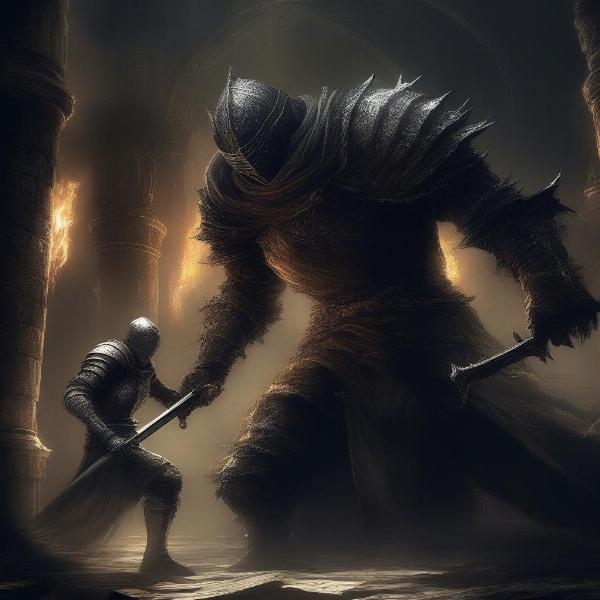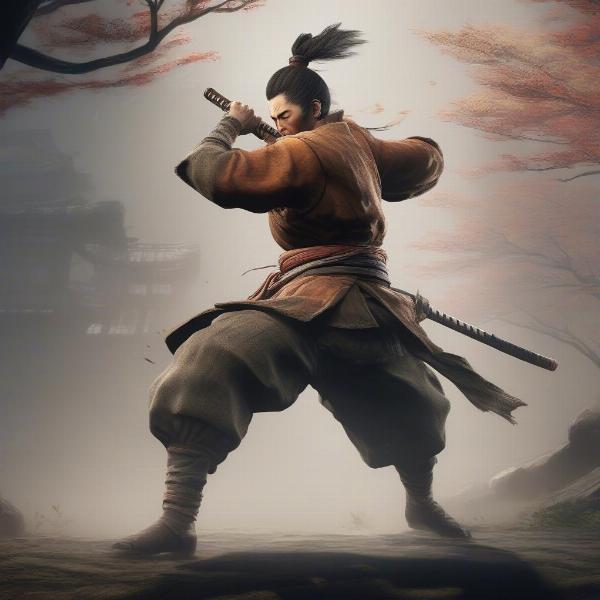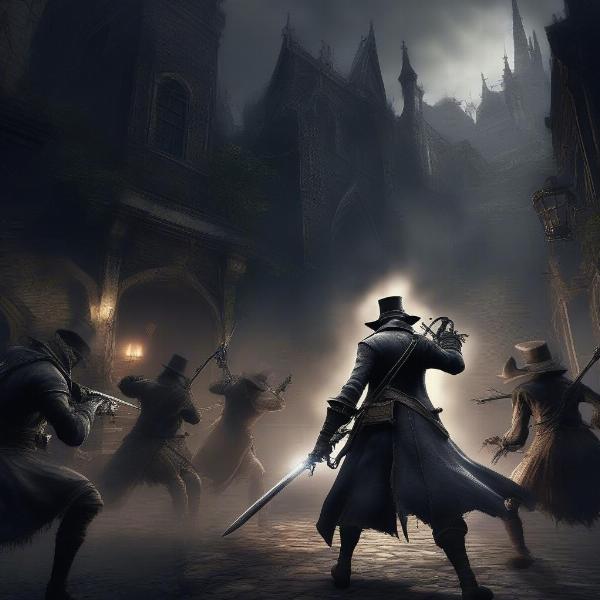The Soulsborne genre, known for its challenging gameplay, has sparked countless debates about which entry reigns supreme in difficulty. FromSoftware’s meticulously crafted worlds are filled with brutal enemies, intricate level design, and unforgiving bosses, leaving players to question: What Is The Hardest Soulsborne Game? This article delves into the intricacies of Soulsborne difficulty, exploring various factors that contribute to the challenge and examining each game to determine the true champion of pain.
Dissecting Soulsborne Difficulty: More Than Just Big Bosses
Soulsborne difficulty is a multifaceted beast. It’s not just about having high HP bosses or attacks that one-shot you. It’s about the intricate interplay of enemy design, level design, and the player’s own build and skill. Some games punish aggressive playstyles, while others demand precision and patience. Understanding the nuances of each game’s mechanics is crucial to surviving, let alone conquering.
- Enemy Design: FromSoftware excels at creating enemies that are both challenging and engaging. Their attacks are often telegraphed, but require precise timing to dodge or parry. Moreover, enemy placements are strategically designed to create ambushes and force players to think tactically.
- Level Design: The interconnected worlds of Soulsborne games are often as much of a foe as the enemies themselves. Devious traps, hidden pathways, and shortcuts that loop back on themselves can disorient and frustrate even the most seasoned players.
- Build and Skill: The Soulsborne genre encourages experimentation with different builds and playstyles. However, some builds are more effective than others, and mastering the game’s mechanics, such as parrying and backstabbing, can significantly impact the difficulty.
Ranking the Soulsborne Games by Difficulty
While difficulty is subjective, certain games consistently rank higher in terms of overall challenge. Let’s analyze each major entry in the series:
Demon’s Souls: The Grandfather of Challenge
Demon’s Souls, the game that started it all, is notoriously difficult, especially for newcomers. Its unforgiving world and obtuse mechanics can be a significant hurdle. World Tendency, a unique mechanic that affects enemy strength and item drops, adds another layer of complexity.
Dark Souls: Prepare to Die Edition – Living Up to Its Name
Dark Souls builds upon the foundation laid by Demon’s Souls, refining the formula and introducing new challenges. The interconnected world is more complex, and the boss fights are arguably more demanding. Blighttown, a notoriously difficult area, is a testament to the game’s challenging level design.
Dark Souls II: Punishing and Deliberate
Dark Souls II is often considered the most punishing entry in the series. Its slower, more deliberate combat requires precise timing and patience. The adaptability stat, which governs the speed of actions like dodging and healing, adds a unique layer of complexity to builds.
Dark Souls III: A Refined and Intense Experience
Dark Souls III combines the best elements of its predecessors, offering a refined and intense experience. The faster combat is reminiscent of Bloodborne, while the interconnected world harkens back to the first Dark Souls. Boss fights are fast-paced and demanding, requiring quick reflexes and strategic thinking.
 Dark Souls 3 Boss Fight – Intense and Challenging
Dark Souls 3 Boss Fight – Intense and Challenging
Bloodborne: A Fast-Paced, Aggressive Dance of Death
Bloodborne deviates from the traditional Soulsborne formula with its faster, more aggressive combat. The lack of shields encourages a more offensive playstyle, demanding precise dodging and parrying. The gothic, Lovecraftian setting adds to the game’s overall atmosphere of dread and tension.
Sekiro: Shadows Die Twice – Mastering the Art of Deflection
Sekiro: Shadows Die Twice, while sharing many similarities with the Soulsborne games, introduces a unique combat system centered around parrying and posture. The focus on precise timing and deflection makes Sekiro arguably the most mechanically demanding game in FromSoftware’s catalog.
 Sekiro Shadows Die Twice Parry – Mastering Deflection
Sekiro Shadows Die Twice Parry – Mastering Deflection
So, What IS the Hardest Soulsborne Game?
The answer, ultimately, is subjective. While each game presents its unique challenges, Sekiro: Shadows Die Twice often takes the crown for its demanding combat system. Its emphasis on precise parrying and posture management requires a level of mastery unlike any other Soulsborne game. However, Dark Souls II’s punishing gameplay and Dark Souls’ intricate level design can also provide a significant challenge, especially for newcomers.
Beyond the Core Games: DLC and Challenge Runs
The difficulty of Soulsborne games can be further amplified through DLC content and challenge runs. DLC often features some of the toughest bosses and areas in the entire game. Challenge runs, such as no-hit runs or specific build restrictions, add another layer of complexity and difficulty.
Expert Opinion:
“While Sekiro demands technical mastery, Dark Souls II punishes mistakes relentlessly. Both offer unique challenges that push players to their limits.” – Dr. Emily Carter, Soulsborne Scholar and Game Designer
 Bloodborne Fast Paced Combat – Aggressive and Relentless
Bloodborne Fast Paced Combat – Aggressive and Relentless
Embracing the Challenge
The difficulty of Soulsborne games is part of their appeal. The sense of accomplishment after overcoming a challenging boss or navigating a treacherous area is unparalleled. So, pick up a controller, embrace the challenge, and prepare to die… a lot. Share your thoughts on the hardest Soulsborne game in the comments below!
Exploring the Soulsborne Universe: Lore and Community
The rich lore and vibrant community surrounding Soulsborne games add to their enduring appeal. From dissecting cryptic item descriptions to sharing tips and strategies, the community plays a vital role in the Soulsborne experience.
FromSoftware’s Legacy of Challenge: Beyond Soulsborne
FromSoftware’s influence extends beyond the Soulsborne genre. Games like Elden Ring have adopted similar mechanics and design philosophies, further solidifying the studio’s legacy of challenging gameplay.
The Future of Soulsborne Difficulty: What Lies Ahead?
As FromSoftware continues to innovate, it will be interesting to see how they evolve the Soulsborne formula. Will future games continue to push the boundaries of difficulty, or will they explore new avenues of challenge?
Conclusion
Determining the hardest Soulsborne game is a complex discussion with no definitive answer. Each entry offers unique challenges, catering to different playstyles and preferences. While Sekiro often holds the title for its demanding combat, the punishing nature of Dark Souls II and the intricate level design of Dark Souls can prove equally daunting. Ultimately, the hardest Soulsborne game is the one that pushes you to your limits. What are your thoughts? Let us know in the comments below which game you found the most challenging and why!
FAQ:
-
What does Soulsborne mean? Soulsborne refers to a subgenre of action RPGs characterized by challenging gameplay, intricate level design, and a focus on atmosphere and lore, originating with Demon’s Souls and popularized by the Dark Souls series.
-
Is Elden Ring a Soulsborne game? While sharing many similarities, Elden Ring is often considered its own subgenre due to its open-world design, but it inherits many of the core elements that define Soulsborne games.
-
What makes Soulsborne games so hard? The difficulty stems from a combination of factors: deliberate combat, challenging enemy AI, intricate level design, and a lack of hand-holding.
-
Which Soulsborne game is best for beginners? Many argue that Dark Souls III offers a good balance of challenge and accessibility, making it a decent starting point for newcomers.
-
What is World Tendency in Demon’s Souls? World Tendency is a hidden mechanic that influences enemy strength, item drops, and even world events based on player actions and online interactions.
-
What is the Adaptability stat in Dark Souls II? Adaptability governs the speed of actions like dodging, rolling, and using items, making it a crucial stat for mitigating the game’s deliberate combat.
-
What is posture in Sekiro: Shadows Die Twice? Posture represents an enemy’s ability to block attacks. Breaking an enemy’s posture opens them up to a devastating deathblow.

